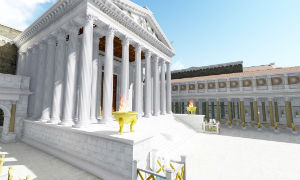Take a virtual tour of ancient Rome in this free online course
07 March 2017

A guided tour of ancient Rome will be made available online in a world’s first as part of a free course by the University of Reading.
A unique and incredibly detailed recreation of the Eternal City has been produced for the new online course, allowing students of all ages to explore the city as it looked 1,700 years ago.
The historically accurate model was created over 10 years, and will allow students of all ages to learn about the architecture and history of ancient Rome in an immersive way.
The five-week course, called Rome: A Virtual Tour of the Ancient City and available via FutureLearn, is due to start on 13 March 2017.
Dr Matthew Nicholls, lecturer in the University of Reading’s Classics department and the creator of the digital model, will lead the virtual tour around ancient Rome. He said: “We are offering an immersive and unique virtual tour of the Eternal City without even leaving your living room, and everyone is invited.
“The course encourages students to explore the answers to questions about Roman life amid the buildings that provided a spectacular backdrop to a dramatic and rich period in history.
“Our stunning digital model blends history with modern-day footage of the architecture you might encounter on a holiday there, bringing the city to life as never before.”

The award-winning 3D digital recreation of the ancient city as it looked in 315 AD features 360-degree panoramic images and animations, cut with footage of Dr Nicholls walking the modern-day streets.
Questions to be explored during the MOOC include how the Romans were able to supply drinking water to the million people living in the city, where they worshipped their gods and where political masters made public appearances.
FutureLearn’s Head of Content, Nigel Smith, said: “It’s very exciting to see the opportunities that online learning continues to offer, attracting more and more learners into the educational sphere.
“We’re delighted that our partner, the University of Reading, is encouraging learners to engage with history and that they will be able to immerse themselves in a very real way, thanks to the benefits of learning technologies.”
Those taking the course can expect to become familiar with the architecture and history of Rome, understand how experts study source materials, and learn how to interpret the archaeological ruins scattered throughout the city.
The course is open to anyone with an interest in finding out more about ancient Rome, from those thinking about a holiday there to others interested in studying archaeology, classics or history at university.
For more information, visit the FutureLearn course page. Use the hashtag #FLvirtualrome to join the conversation about the course on Twitter.
The model of ancient Rome was created using SketchUp, Lumion, Cinema 4D and Kubity.
Full list of collaborators:
- University of Reading
- FutureLearn
- British School at Rome
- MotionBlurr
- The Comune di Roma
- Stanford University Forma Urbis project
- Heberden Coin Room, Ashmolean Museum and Dr Jerome Mairat (University of Oxford)
Reading Academics:
- Professor Peter Kruschwitz
- Professor Annalisa Marzano
- Dr Luke Houghton
- Dr Andrew Souter
Reading students:
- James Lloyd
- Claire Dent
- Gilbert McGirr
- Students from Typography and Graphics Communication department
